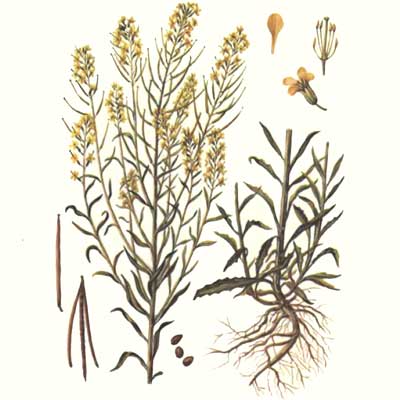Zheltushnik gray – Erysimum extended Karst (IS. Canescens Roth)
Family Brassicaceae (Criciferae) - Cruciferous
Zheltushnik gray - description of the plant
The two-year (rarely perennial) herbaceous plant with root fusiform, which runs in the first year one or more short leafy stems, height 30 cm, priosnovnymi with rosettes, and in the second year - to 20 stems, height of 30-120 cm, erect, branched, coated with a two-part hair, adjacent to the stem. Leaves lanceolate first year, passing in petioles, and the leaves of the second year - oblong or linear with short petioles or sessile. Inflorescences - thick brush on tops of stems and branches stems, before the formation of the fetus they are highly elongated. Flowers on the legs. Sepals 4, petals - 4, obovate, long fingernail, lemon yellow. Stamens 6, Outdoor 2 stamens shorter. Fruit nitevidnыy, tetrahedral, slightly flattened pod green with numerous brownish seeds. It blooms in April - June.
Spread. It grows in dry grassy areas, vacant lots and roadsides. It spreads throughout the country to 120 m. It is found in Central, Eastern and Southeastern Europe.
Raw materials. The above-ground portion has a characteristic odor and a very bitter taste; grass collected during flowering.

The content of active substances in the gray zheltushnik
Active substances zheltushnik - serdechnoaktivnye glycosides - arizimin and erizidozid. They are found in all parts of the plant, though in different amounts; most of them during the flowering. Their content is highest in seeds - from 2 to 6%, then leaves - 1-1.5% in the stalks and - 0.5-0.7%, while the lowest - in the roots - to 0,2%.
Besides seeds contain glycosides and fatty oils - 30-40%. In its composition includes: about 49% oleic acid, about 32% - Erucic acid, 11-12% - Of palmitic, about 4-5% linoleic and about 2,5% linolenic acid.
The medicine used is contained in the plant erizimin, which on hydrolysis gives strofantidin and digitoxose, as well as erizimozid, gidroliticheskie raspadayushtiysya of strofantidin, digitokso-zu and glucose, as it is biozidom.
Experimental and clinical evidence of therapeutic action zheltushnik
Activity is determined by the plants contained therein two glycosides, resembling in its effects strophanthin. Pharmacological characterization of both glycosides similar. They differ mainly on two parameters:
- Erizimozid bioaccumulates relatively more, than erizimin;
- When taken orally it is better resorbed. Through this it can be administered orally, in contrast to erizimina.
Both glycoside have the most significant effect on the heart. In experimental and clinical conditions proved, they possess positive inotropic and negative chronotropic effect. In conditions of simulated cardiac arrhythmias they provided antiarrhythmic effect, expressed in moderation and normalization of heart rate.
With the introduction of these glycosides in acute experimental myocardial infarction they accelerate the healing process, have a positive effect on coronary collateral circulation and, improve and stabilize the ECG changes. Particularly their effects on ECG do not differ significantly from the effects of strophanthin-K.
In terms of the model of myocardial infarction and erizimin erizimozid increase myocardial oxygen consumption. Qualitatively, the effect is similar to that of, and quantitatively even more strongly expressed, than a similar effect strophanthin-K.
As can be seen around the, positive inotropic effect of these glycosides causes moderately pronounced increase in blood pressure, caused by them. However, for this effect plays a certain role and stimulating effect on the cardiovascular center.
Zheltushnik glycosides have also moderately or weakly expressed diuretic effect.
These preparations of zheltushnik shown mainly in cardiovascular disease, developed in the course and on the basis of the mitral heart defects, hypertension and atherosclerotic cardiosclerosis.
Observations have shown in different clinics, that erizimin for therapeutic effect is very close to strofantinu, differing from a mild effect and lower toxicity. As it erizimozida, According to available data, It stands between strofantinom and digitoxin.
Methods of application in medicine zheltushnik
It is important to remember, that apply all drugs zheltushnik only on medical prescription.
Raw zheltushnik can be used in the form of hot infusion: 1,0 g herb to fill 150 ml of water, strain and drink 3-4 tablespoons per day.
Erizimin - ampoule 1 ml of 0.025% aqueous solution, contains 5% ethyl alcohol. Biological Activity, controlled annually, ICE is 16-20 or 2.6-3.0 CUD. Enter intravenously, usually once or twice a day to the maximum single dose of 0,00033 and the maximum daily dose - 0,00066 g.
Erizimozid - pills on 0,0005 g. (= 0,5 mg). Take one tablet 2-3 times a day on an empty stomach (20-30 minutes before eating).
Erysimum also available in the form of an alcohol solution for oral administration – 0,2%. Take 20 drops 3 times a day before meals.
